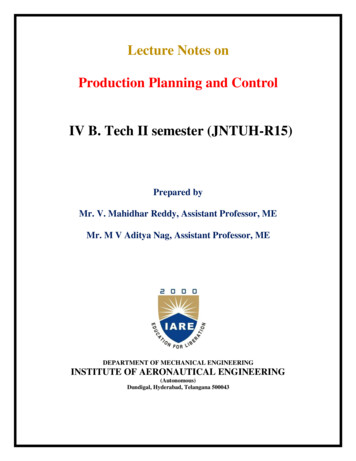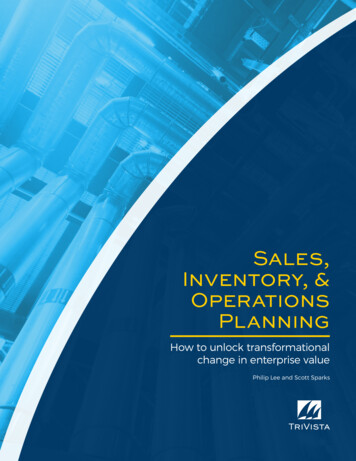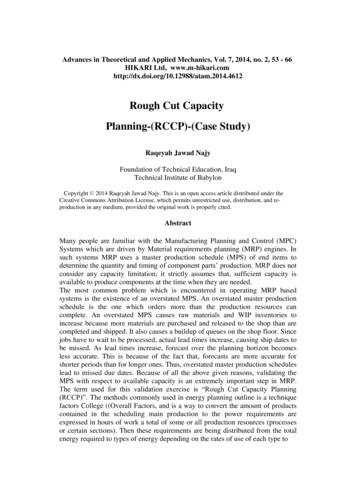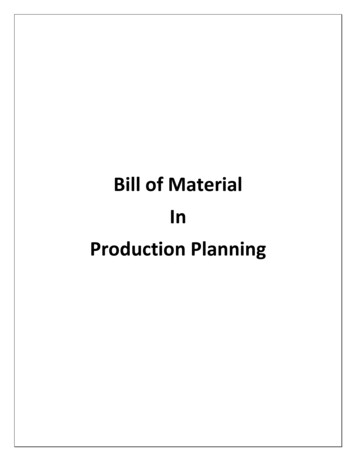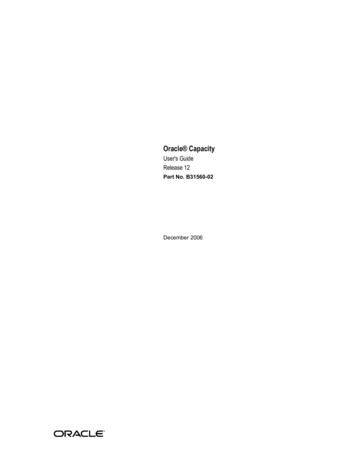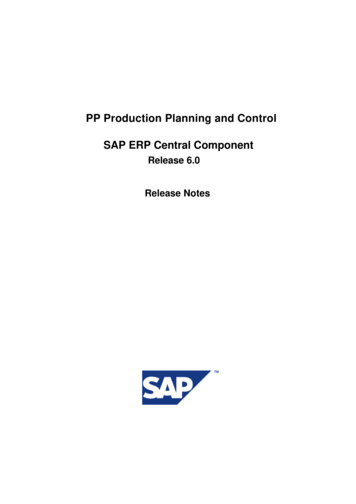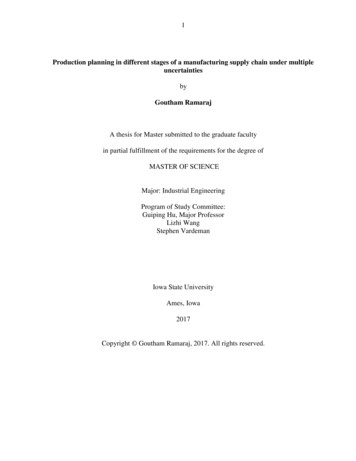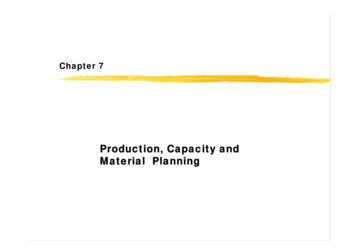
Transcription
Chapter 7Production, Capacity andMaterial Planning
Production, Capacity and MaterialPlanningProduction planquantities of final product, subassemblies, parts needed at distinctpoints in timeTo generate the Production plan we need:end-product demand forecastsMaster production scheduleMaster production schedule (MPS)delivery plan for the manufacturing organizationexact amounts and delivery timings for each end productaccounts for manufacturing constraints and final goods inventoryProduction Management101
Production, Capacity and MaterialPlanningBased on the MPS:rough-cut capacity planningMaterial requirements planningdetermines material requirements and timings for each phase ofproductiondetailed capacity planningProduction Management102
Production, Capacity and terialPlanPurchasingPlanShop FloorControlShopOrdersUpdatesProduction Management103
Master Production SchedulingAggregate plandemand estimates for individual end-itemsdemand estimates vs. MPSinventorycapacity constraintsavailability of materialproduction lead time.Market environmentsmake-to-stock (MTS)make-to-order (MTO)assemble-to-order (ATO)Production Management104
Master Production SchedulingMTSproduces in batchesminimizes customer delivery times at the expense of holding finishedgoods inventoryMPS is performed at the end-item levelproduction starts before demand is known preciselysmall number of end-items, large number of raw-material itemsMTOno finished-goods inventorycustomer orders are backloggedMPS is order driven, consisits of firm delivery datesProduction Management105
Master Production SchedulingATOlarge number of end-items are assembled from a relativelysmall set of standard subassemblies, or modulesautomobile industryMPS governs production of modules (forecast driven)Final Assembly Schedule (FAS) at the end-item level (orderdriven)2 lead times, for consumer orders only FAS lead timerelevantProduction Management106
Master Production SchedulingMPS- SIBUL manufactures phonesthree desktop models A, B, Cone wall telephone DMPS is equal to the demand forecast for each modelWEEKLY MPS( FORECAST)ProductModel AModel BModel CModel Dweekly totalmonthly 0060030003600122004100015002500Production 12200100020032008200035010003350107
Master Production SchedulingMPS Planning - ExampleMPS plan for model A of the previous example:Make-to-stock environmentNo safety-stock for end-items It It-1 Qt – max{Ft,Ot} It end-item inventory at the end of week t Qt manufactured quantity to be completed in week t Ft forecast for week t Ot customer orders to be delivered in week tINITIAL DATA Model ACurrent Inventory 1600forecast Ftorders on Management52000100FebWeek672000200082000108
Master Production SchedulingBatch production: batch size 2500 It max{0, It-1 } – max{Ft, Ot} 0, if I t 0Qt 2500, otherwise I1 max{0, 1600} – max{1000, 1200} 400 0 I2 max{0, 400} – max{1000, 800} -600 0 Q2 2500 I2 2500 400 – max{1000, 800} 1900, etc.MPSJanFebWeekWeekCurrent Inventory 16001234567forecast Ft1000100010001000200020002000orders Ot1200800300200100Inventory It1600400190090024004009001400MPS Qt2500250025002500ATP4001400220025002500Production Management82000190025002500109
Master Production SchedulingAvailable to Promise (ATP) ATP1 1600 0 – 1200 400 ATP2 2500 –(800 300) 1400, etc. Whenever a new order comes in, ATP must be updatedLot-for-Lot productionMPSCurrent Inventory 1600forecast Ftorders OtInventory It1600MPS 00007004100020001000800Production 20002000020002000020002000110
Master Production SchedulingMPS Modelingdiffers between MTS-ATO and MTOfind final assembly lot sizesadditional complexity because of joint capacity constraintscannot be solved for each product independentlyProduction Management111
Master Production SchedulingMake-To-Stock-ModelingQit production quantity of product i in period tIit Inventory of product i at end of period tDit demand (requirements) for product i in time period ta i production hours per unit of product ih i inventory holding cost per unit of product i per time periodA i set-up cost for product iG t production hours available in period tyit 1,if set-up for product i occurs in period t (Qit 0)Production Management112
Master Production SchedulingMake-To-Stock-ModelingnTmin ( Ai yit hi I it )i 1 t 1I i ,t -1 Qit I it Ditn a Qi 1iit Gtfor all (i,t)for all tTQit yit Dik 0for all (i,t)k 1Qit 0; I it 0; yit {0,1}Production Management113
Master Production SchedulingAssemble-To-Order Modelingtwo master schedulesMPS: forecast-drivenFAS: order drivenoverage costsholding costs for modules and assembled productsshortage costsfinal product assemply based on available modulesno explicit but implicit shortage costs for modulesfinal products: lost sales, backordersProduction Management114
Master Production Schedulingm module types and n product typesQkt quantity of module k produced in period tgkj number of modules of type k required to assemble order jDecision Variables:Ikt inventory of module k at the end of period tyjt 1, if order j is assembled and delivered in period t; 0, otherwisehk holding costπjt penalty costs, if order j is satisfied in period t and order j is due inperiod t’ (t’ t); holding costs if t’ tProduction Management115
Master Production SchedulingAssemble-To-Order ModelingmLnLmin hk I kt π jt y jtk 1 t 1j 1 t 1subject tonI kt I k ,t 1 Qkt g kj y jtfor all (k, t)j 1n aj 1jy jt GtL yt 1jtfor all t 1I kt 0;for all jy jt {0,1}Production Managementfor all (j, k, t)116
Master Production SchedulingCapacity PlanningBottleneck in production facilitiesRough-Cut Capacity Planning (RCCP) at MPS levelfeasibilitydetailed capacity planning (CRP) at MRP levelboth RCCP and CRP are only providing informationProduction Management117
Master Production ek231000100050050015001500600410001500-Bill of capacity (min)Assembly Inspection202242.5222252.4Capacity requires 28!! weekly capacityrequirements? Assembly: 1000*20 1500*22 600*25 68000min 1133,33 hr Inspection: 1000*2 1500*2 600*2,4 6440 min 107,33 hr etc. available capacity per weekis 1200 hr for the assemblywork center and 110 hoursfor the inspection station;Availablecapacity4 per week883120083110Production Management118
Master Production SchedulingInfinite capacity planning (information providing)finding a feasible cost optimal solution is a NP-hard problemif no detailed bill of capacity is available: capacity planning usingoverall factors (globale Belastungsfaktoren)required input:MPSstandard hours of machines or direct labor requiredhistorical data on individual shop workloads (%)Example from Günther/TempelmeierC133.3: overall factorsProduction Management119
Master Production Schedulingcapacity planning using overall factorsweek280-productAB110040productABwork oncritical machine143120604100-512040660-work onnon-critical machine22Total36historic capacity requirements on critical machines:40% on machine a60% on machine bProduction Management120
Master Production Schedulingin total 500 working units are available per week, 80 on machine aand 120 on machine b;Solution:overall factor time per unit x historic capacity needsproduct A:machine a: 1 x 0,4 0,4machine b: 1 x 0,6 0,6product B:machine a: 4 x 0,4 1,6machine b: 4 x 0,6 2,4Production Management121
Master Production Schedulingcapacity requirements: product 05487224062436120capacity requirements: product duction Management122
Master Production Schedulingtotal capacity 1442163604060200Production Management561121683202436120123
capacity requirementsMaster Production Scheduling400300a (max 80)200b (max 120)other (max 300)1000123456weekProduction Management124
Master Production SchedulingCapacity Modelingheuristic approach for finite-capacity-planningbased on input/output analysisrelationship between capacity and lead timeG work center capacityRt work released to the center in period tQt production (output) from the work center in period tWt work in process in period tUt queue at the work center measured at the beginning of period t,prior to the release of workLt lead time at the work center in period tProduction Management125
Master Production SchedulingQt min{G, U t 1 Rt }U t U t 1 Rt QtWt U t 1 Rt U t QtWtLt GLead time is not constantassumptions:constant production rateany order released in thisperiod is completed in thisperiodProduction Management126
Master Production 4812163030604448520,830,831,671,221,331,44G (hr/week)Rt (hours)Qt (hours)Ut (hours)W t (hours)Lt(weeks)Production Management436203653640366364036127
Material Requirements PlanningInputsmaster production scheduleinventory status recordbill of material (BOM)Outputsplanned order releases purchase orders(supply lead time) workorders(manufacturing lead time)Production Management128
Material Requirements PlanningLevel 0End-Item 1Legend:S/ALevel 12S/A subassembly1Level 2PP 10124RM raw material2MP 9Level 4 RM 12MP manufactured part6S/APP 54Level 3PP purchased partpart #quantityRM 132Production Management129
Material Requirements PlanningMRP Processgoal is to find net requirements (trigger purchase and work orders)explosion Example: MPS, 100 end items yields gross requirementsnetting Net requirements Gross requirements - on hand inventory - quantity onorder done at each level prior to further explosionoffsetting the timing of order release is determinedlotsizing batch size is determinedProduction Management130
Material Requirements PlanningExample 7-6TelephoneHand Set 11AssemblyBase12Assembly11HousingS/AMicrophone 111S/A11ReceiverS/A1TappingScrew112115HandSet Cord1121Board Pack pingScrew411413KeyPadProduction Management 11211KeyPad Cord11212131124
Material Requirements PlanningPART 11 (gross requirements given)net requirements?Planned order release?Net requ.(week 2) 600 – (1600 700) -1700 Net requ.(week2) 0Net requ.(week 3) 1000 – (1700 200) -900 Net requ.(week3) 0Net requ.(week 4) 1000 – 900 100 0001002000200020002000planned receiptsplanned orderreleaseProduction Management132
Material Requirements PlanningAssumptions:lot size: 3000lead time: 2 ected inventorybalancenet requirementsplanned receiptsplanned 020003000290020003000900200030003000Production Management133
Material Requirements PlanningMultilevel explosionpart number121211231211descriptionQtybase assemblyhousing S/Arubber padkey pad1141lead time is one weeklot for lot for parts 121, 123, 1211part 12: fixed lot size of 3000Production Management134
Part 12gross requirementsscheduled receiptsprojected inventory balancenet requirementsplanned receiptsplanned order releasecurrentPart 121gross requirementsscheduled receiptsprojected inventory balancenet requirementsplanned receiptsplanned order 05300000030000030003000x4500Part 123gross requirementsscheduled receiptsprojected inventory balancenet requirementsplanned receiptsplanned order releasecurrent0Part 1211gross requirementsscheduled receiptsprojected inventory balancenet requirementsplanned receiptsplanned order 30000030000Production 0135
Material Requirements PlanningMRP Updating MethodsMRP systems operate in a dynamic environmentregeneration method: the entire plan is recalculatednet change method: recalculates requirements only for those itemsaffected by eek67200020001000300200820003501000-Updated MPS for 00300200-Net Change for FebruaryWeek5678300-100150200-200-200Production Management136
Material Requirements PlanningAdditional Netting proceduresimplosion: opposite of explosion finds common itemcombining requirements: process of obtaining the gross requirements of a common itempegging: identify the item’s end product useful when item shortages occurProduction Management137
Material Requirements PlanningLot Sizing in MRPminimize set-up and holding costscan be formulated as MIPa variety of heuristic approaches are availablesimplest approach: use independent demand procedures (e.g. EOQ) atevery levelProduction Management138
Material Requirements PlanningMIP FormulationIndices:i 1.Pt 1.Tm 1.Mlabel of each item in BOM (assumed that all labels are sorted withrespect to the production level starting from the end-items)period tresource mParameters:Γ(i)Γ-1(i)sicijhiamibmiLmtocmGDitset of immediate successors of item iset of immediate predeccessors of item isetup cost for item iquantity of itme i required to produce item jholding cost for one unit of item icapacity needed on resource m for one unit of item icapacity needed on resource m for the setup process of item iavailable capacity of resource m in period tovertime cost of resource mlarge number, but as small as possible (e.g. sum of demands)external demand of item i in period tProduction Management139
Material Requirements PlanningDecision variables:xitIitOmtyitdeliverd quantity of item i in period tinventory level of item i at the end of period tovertime hours required for machine m in period tbinary variable indicating if item i is produced in period t ( 1) or not ( 0)Equations:P TT Mi 1t 1t 1m 1min ( si yit hi I it ) ocmOmtI i ,t I i ,t 1 xi ,t P cj Γ ( i )ijx jt Dit (ami xit bmi yit ) Lmt Omti 1 i, txit Gy it 0 i, t m, txit , I it , Omt 0,yit {0,1} i, m, tProduction Management140
Material Requirements PlanningMulti-Echelon SystemsMulti-echelon inventoryeach level is referred as an echelon“total inventory in the system varies with the number of stockingpoints”Modell (Freeland 1985): demand is insensitive to the number of stocking points demand is normally distributed and divided evenly among the stockingpoints, demands at the stocking points are independent of one another a (Q,R) inventory policy is used β-Service level (fill rate) is applied Q is determined from the EOQ formulaProduction Management141
Material Requirements PlanningReorder point in (Q,R) policies:i: total annual inventory costs (%)c: unit costsA: ordering costsτ :lead timeσ τ : variance of demand in lead timegiven a fill rate βchoose z ( β ) such that:L ( z ) ( y z ) φ ( y ) dy zφ:(1 β )Qστdensity of N(0,1) distribution; L(z): standard loss functionProduction Management142
Unit Normal Linear Loss Integral 0018.0017Production 7.0050.0037.0028.0022.0016143
Material Requirements Plannings z σ τSafety stock:Reorder point:R Dτ z σ τOrder quantity:Q EOQ 2ADicAverage inventory: I (1) Q s2I ( n ) average inventoryI (1) 12for n stockingpoints2A D zσ τicProduction Management144
Material Requirements Planningfor two stocking points :demand at each point : D/2variance of lead - time demand : σ τ2 / 2standard deviation is : σ τ / 2average inventory at each stocking point is :1 2AD/2 zσ τ1 (Q / 2 s )2ic22Production Management145
Material Requirements Planningthe average inventory for two stocking point is : 1 I (2) 2 (Q / 2 s ) 2 (Q / 2 s ) 2 I (1) 2I (n) n I (1)for each level the safety stock is : s/ nthe total safety stock is n sProduction Management146
Material Requirements PlanningExample: At the packaging department of a sugar refinery:A very-high-grade powdered sugar:BoxedSugarLevel 0Level 1SugarCartonsSugar-refining lead time is five days;Production lead time (filling time) is negligible;Annual demand: D 800 tons and σ 2,5Lead-time demand is normally distributed with Dτ 16 tons and στ 3,54 tonsFill rate 95%A 50, c 4000, i 20%Production Management147
Material Requirements PlanningInventory at level 0 and 1? Safety stock?2 AD icQ 2 x 50 x 800 10 tons800ß 0,95 z 0,71s zστ 0,71x3,54 2,51 tonsSuppose we keep inventory in level 0 only, i.e., n 1:I (1) Q10 s 2,51 7 ,51tons22Suppose inventory is maintained at both level 0 and level 1, i.e., n 2:I (2) 2 I (1) 10 , 62 tonsThe safety stock in each level is going to be:s2,51 1,77tons22Production Management148
Material Requirements PlanningMRP as Multi-Echelon Inventory Controlcontinuous-review type policy (Q,R)hierarchy of stocking points (installation)installation stock policyechelon stock (policy): installation inventory position plus alldownstream stockMRP: rolling horizon level by level approach bases ordering decisions on projected future installation inventory levelProduction Management149
Material Requirements Planning All demands and orders occur at the beginning of the time period orders are initiated immediately after the demands, first for the final itemsand then successively for the components all demands and orders are for an integer number of units T planning horizon τi lead time for item i si safety stock for item I Ri reorder point for item I Qi Fixed order quantity of item i Dit external requirements of item i in period tProduction Management150
Material Requirements PlanningInstallation stock policies (Q,Ri) for MRP:a production order is triggered if the installation stock minus safetystock is insufficient to cover the requirements over the next τi periodsan order may consist of more than one order quantity Qif lead time τi 0, the MRP is equal to an installation stock policy.safety stock reorder pointProduction Management151
Material Requirements PlanningEchelon stock policies (Q,Re) for MRP:Consider a serial assembly systemInstallation 1 is the downstream installation (final product)the output of installation i is the input when producing one unit of itemi-1 at the immediate downstream installationwi installation inventory position at installation iIi echelon inventory position at installation i (at the same moment)Ii wi wi-1 . w1a multi-echelon (Q,R) policy is denoted by (Qi,Rie)Rie gives the reorder point for echelon inventory at iProduction Management152
Material Requirements PlanningR1e s1 Dτ1Rie si Dτi Ri-1e Qi-1Example:Two-level system, 6 periodsI 10 18 , I 20 38 , R 1e 20 , R 2e 34 , Q 1 10 , Q 2 30D 2 (Item 1), τ1 1, τ2 2Production Management153
Material Requirements PlanningItem 1Item 2PeriodDemandLevel w1ProductionLevel w2Production12181010022260100322401030Suppose now that five units were demanded in period 2:Period2345Demand5222Level w123211927Item 1Production00100Level w210103030Item on Management6228010072230300154
Material Requirements PlanningLot Size and Lead Timelead time is affected by capacity constraintslot size affects lead timebatching effectan increase in lot size should increase lead timesaturation effectwhen lot size decreases, and set-up is not reduced, lead time willincreaseexpected lead time can be calculated using models from queueingtheory (M/G/1)Production Management155
Material Requirements PlanningL lead time(λ / μ ) 2 λ2σ 2 1 L 2λ (1 λ / μ )μλ mean arrival rateμ mean service rateσ 2 service time varianceProduction Management156
Material Requirements PlanningD j demand per period for productt j unit - productionjtime for productS j set - up time for productQ j lotsize for productjjjmean arrival rate of batches :nn Dλ λj jj 1j 1 Q jmean service time :n1μ λj 1( S j t jQ j )jn λj 1service - time variance :nσ2 λj 1jj( S j t jQ j ) 2n λj 1Production Managementj 1 μ 2157
Material Requirements PlanningProduction Management158
Material PlanningWork to do: 7.7ab, 7.8, 7.10, 7.11, 7.14 (additional information:available hours: 225 (Paint), 130 (Mast), 100 (Rope)), 7.15, 7.16,7.17, 7.31-7.34Production Management159
Production Management. 108. Master Production Scheduling. a. MPS Planning - Example MPS plan for model A of the previous example: Make-to-stock environment No safety-stock for end-items I. t I. t-1 Q. t –max{F. t,O. t} I. t end-item inventory at the end of week t Q. t


